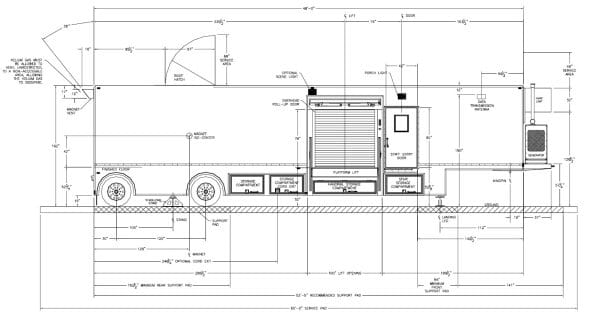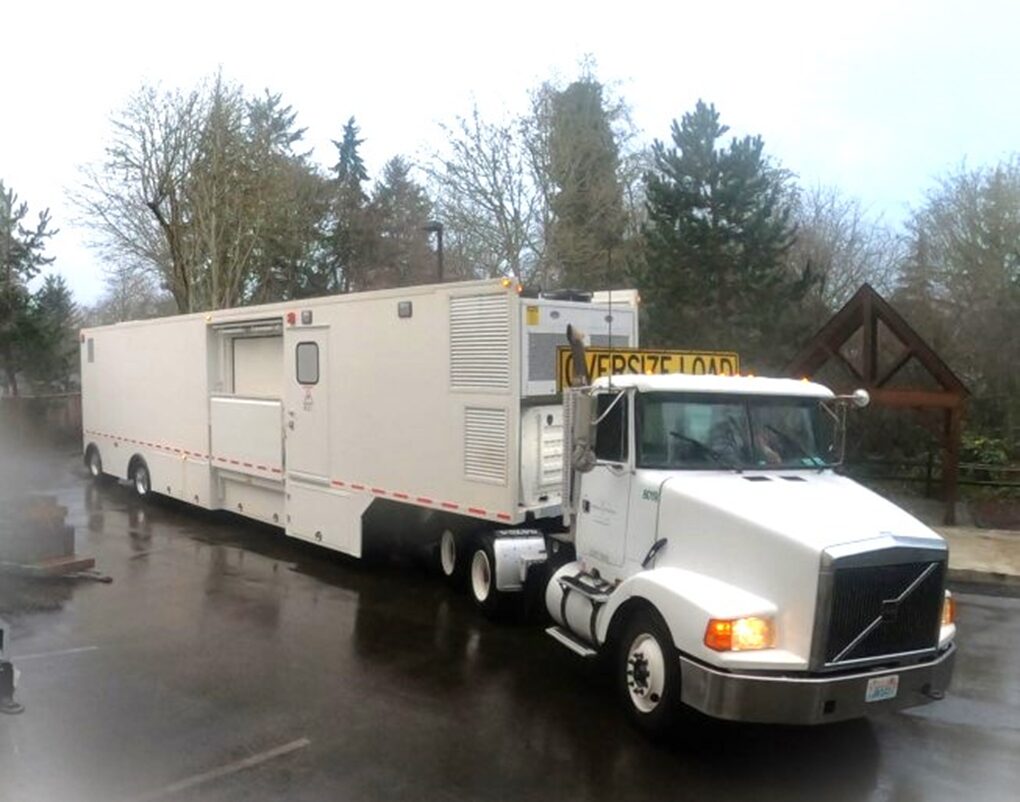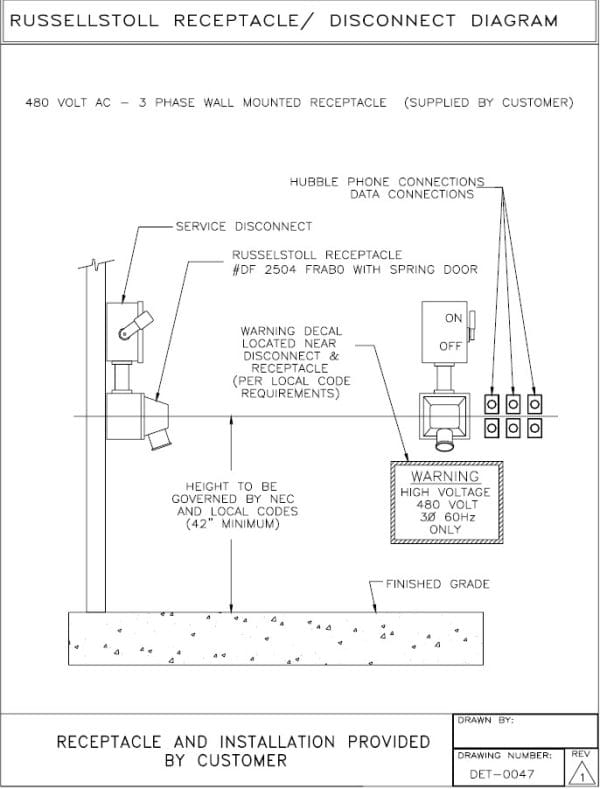Renting mobile imaging equipment is an excellent way to provide your patients with the care they need, while avoiding the significant costs associated with purchasing a fixed system and preparing dedicated space for it. When renting a mobile unit, there are a few essential requirements to consider: you’ll need proper power (480V, 3-phase, 150-200 amps), 8-10 parking spaces to accommodate the system, and in states such as California, Florida, and Michigan, facilities are required to obtain special compliance certifications to bring in a mobile MRI and mobile CT units. Additionally, the trailers must meet state specific compliance requirements. In this post, we’ll walk you through the step-by-step process of bringing a mobile imaging system to your location.
TRAILER SIZE
 Trailer sizes vary, however the most used trailers are typically 48’ long, 8’ wide, and 13’ 6 high tall. The patient lift generally extends 58” – 60” from the side of the trailer and the generator and HVAC units increase the overall length of the trailer to 53’. We provide site planning guides specific to each mobile unit.
Trailer sizes vary, however the most used trailers are typically 48’ long, 8’ wide, and 13’ 6 high tall. The patient lift generally extends 58” – 60” from the side of the trailer and the generator and HVAC units increase the overall length of the trailer to 53’. We provide site planning guides specific to each mobile unit.
LOCATION
The location where you place a mobile unit is very important for several reasons, impacting its efficiency, patient safety, and overall operation. Here are some key factors to consider:
Safety Considerations
• Mobile MRI (Magnetic Field Interference): The powerful magnets in MRI machines create a large magnetic field that can interfere with nearby electronic devices. The MRI should be placed away from sensitive equipment and areas where its magnetic field could disrupt normal operations. We generally recommend 10 feet away from any moving traffic or steel structures.
• Safety Zones: MRI machines have designated safety zones around them (typically three zones: Zone I, II, and III) to ensure that only authorized personnel are near the machine. The placement should ensure that these zones are clearly marked and accessible to trained staff only.
• Fire Safety & Ventilation: The MRI room needs proper ventilation and cooling systems due to the heat generated by the machine. Also, safety protocols for fire suppression should be considered.
• Mobile CT (Radiation Safety): CT machines use ionizing radiation, so it’s essential to place them in locations that minimize radiation exposure to staff, patients, and others. Proper shielding, such as lead-lined walls, is critical to ensure that radiation is contained within the room.
• Radiation Protection Zones: The room or area around the CT machine must be designated as a radiation safety zone, with restricted access for individuals who are not properly trained or authorized to be in the area. Clear signage and safety protocols are required.
• Ventilation: Some CT scanners, especially older models or high-powered ones, may generate heat. Adequate ventilation is important to maintain the correct operating temperature and prevent overheating of the machine.
Accessibility
• Patient Access: The Mobile unit should be placed in a location that is easily accessible to patients, considering factors such as patient flow, ease of transport (wheelchairs, stretchers), and proximity to waiting areas or emergency departments.
• Transport Pathways: They should be situated in a place with convenient access to the areas where patients will be brought in, without obstacles or narrow corridors that might make the process difficult.
PAD SIZE, WEIGHT and LEVELNESS CONSIDERATIONS
When renting a mobile system, such as a mobile MRI or Mobile CT scanner, the pad size, weight capacity, and levelness are crucial factors that need to be carefully considered. Here’s an overview of each requirement:
Pad Size
- Recommended Dimensions: Typically, the pad should be 53 feet long and 14 feet wide for most mobile systems. This size provides ample space for the mobile unit, along with necessary clearance for service access and equipment. However, a full-length pad is not always necessary. Alternatively, you can place pads under the landing legs of the mobile unit, which are typically 4×4 ½ in size. This approach is the most economical option.
Weight Capacity
- MRI Systems: The pad must be able to support approximately 60,000 lbs. for an MRI unit. MRI machines are particularly heavy due to their magnets and other components, so the pad should be structurally sound to handle this weight without risk of sinking or damage.
- CT Systems: The pad needs to handle about 48,500 lbs. for a CT scanner. While CT machines are generally lighter than MRI units, they still require a solid foundation for proper operation.
Levelness
- Deviation Tolerance: Ideally, the support pad should not exceed a 0.125-inch deviation over a 10-foot span. This ensures that the mobile unit is level, which is critical for both the accuracy of imaging and the longevity of the equipment.
- Deviations: While slight deviations above this threshold may be tolerated, they may necessitate additional adjustments, which could lead to extra costs. Such deviations would require prior approval to ensure compatibility with the mobile system.
- Proper planning of the pad size, weight capacity, and levelness ensures safe, efficient operation of the mobile system, minimizing risks to equipment and optimizing patient care.
Power Requirements and other connections for Mobile systems:
Mobile MRI and Mobile CT systems generally require the following power setup:
- Voltage and Phase: The systems typically require 480 volts with a three-phase electrical hook-up.
- Amperage: The required current is usually between 150 to 200 amps depending on the specific system and model.
Connector Placement
- RussellStoll Connector: It is recommended that the female RussellStoll connector be located no more than 40 feet from the trailer. This allows the 50-foot power cord to easily reach the onboard power supply. Proper placement of the connector ensures safe and efficient electrical connection.
Ensuring the proper power supply, correct placement of electrical connections, and maintaining clean, stable power are crucial for the reliable operation of mobile MRI and mobile CT units. This will significantly reduce downtime and minimize interruptions to your scanning process.
Other Considerations
In addition to telephone connections, some hospitals and imaging centers may require the mobile unit to be equipped with an oxygen tank. While this is typically provided by the hospital, portable oxygen tanks are also available if needed. Other options, such as a portable sink, can also be added. All our mobile units are equipped with magnet monitoring devices, which are essential for detecting any fluctuations or issues with the magnet. These devices also alert to any chiller problems that could cause the system to stop functioning or, in the worst case, result in magnet quenching.
Platinum Mobile Imaging Can Help You Along the Way
Mobile imaging rentals offer an excellent solution for healthcare providers looking to upgrade their in-house system and for those who lack the space or the capital budget for an on-site unit. If you are considering renting a mobile imaging system, please contact us today. We’d be happy to answer any questions and assit you find the best solution to meet your specific needs.
Give us a call today at (833) 966-2445 or contact us online to find out more about the site requirements for mobile imaging rental.
Still have questions? Check out our blog where we explore the question, Is Mobile Imaging Rental Right for You?



